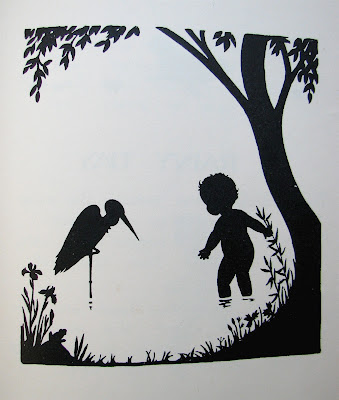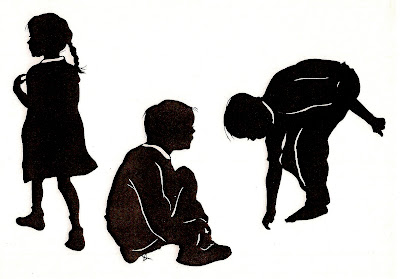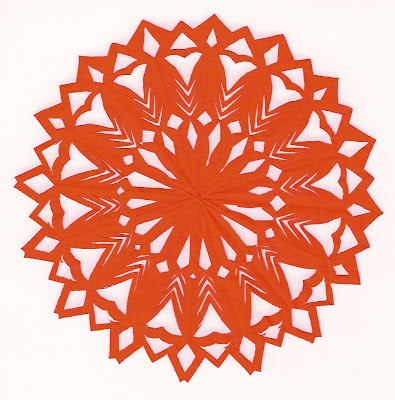I'm not sure why, but I always have urges to do cut paper crafts at Christmas (which is why the floors are always covered in tiny scraps at the holidays).
The two paper cuts above were leftovers from a flurry I cut one year to decorate packages. They're basically just the snowflake idea. I precut thin paper (these were origami paper) into a circle, folded it in half (right sides together), in half again, and then into thirds and then cut patterns out freehand. There are a few simple tips that may help you make especially intricate ones: first, do the folding carefully and press the creases well (you can even iron them). Second, have a mixture of large cut away areas and others that are narrow and repeating. Be sure to use very sharp scissors; I use embroidery scissors. (Though check out these
amazing Polish paper cuts that were traditionally made with sheep shears!) Finally, take care not to tear delicate areas when you unfold them. (Small tears can be repaired by gluing narrow support pieces to the back of the paper cut.) I always iron my finished piece flat.

The paper cut above was done by my oldest son when he was almost 10, and the similar one below was cut when he was not quite 5. You can see he gained a lot of skill in the years between. In both cases, I folded a piece of paper for him (right sides together) and drew one image onto the wrong side, making sure I had an area of join along the fold. By 10 he was able to cut the design out pretty accurately by himself. I showed him how to trim the excess paper close to the drawn lines and then to cut into tight areas, removing sections at a time, rather than trying to cut along the whole perimeter. When he was younger, I held
By: Julie Larios,
on 12/14/2009
Blog:
JACKET KNACK
(
Login to Add to MyJacketFlap)
JacketFlap tags:
Silhouettes,
Add a tag
Interesting trend, the number of silhouette-style compositions on kids' book covers lately. Besides being dramatic almost by definition (contrast heightens drama), it's also a shortcut. In the same ways photos send a signal that a book is modern, the silhouette telegraphs one key piece of information before the books is ever picked up, much less read. It says, "This book is not modern. The story between the covers, whether non-fiction or fiction, will either be set in the past or will have an old-fashioned tone that reminds you of books you loved from your childhood."
The Penderwicks might have been the first one that caught your eye, and its appeal is old-fashioned:
And certainly you've been seeing these two everywhere - both stories (one fiction, one not) set in the past:
You might not have seen the one pictured below yet (only partially silhouette, down in the bottom left corner, but certainly of the Silhouette School) since it's not due out from Henry Holt until next April...it's based on one of Grimm's fairy tales called Bearskinner:
The template (old-fashioned storytelling or set in the past) holds for these as well, from the artist David Frankland, who appears to have a thing for pointy rooflines in the distance:

Sara Reading, copyright 1997
I love silhouette art. The stark black and white contrast, the carefully picked out details, the sense of shape and mass - just utterly beautiful to me. I remember going to have my portrait cut as a child in Cleveland by the silhouette artist Wally Spatz, who was a traveling regular to department stores around the midwest. Her speed and accuracy were truly amazing.
I cannot even approach her finesse with scissors, and I definitely can't work freehand. The portrait above is a papercut made from a drawing I did of my daughter Sara and was loosely modeled on a black and white
woodcut silhouette of a nude on a bed by the Swiss artist Felix Vallotton. I transferred the drawing onto black silhouette paper and cut it out with an xacto knife (and it took many, many hours). I always cut the smallest interior "whites" first, and save the largest areas for last.
I trace my own interest in this kind of art back to even before I had my own silhouette cut, to children's books illustrated with silhouettes, created in a number of ways. I owned several Arthur Rackham books, and he often had spot silhouette illustrations, though I believe they were largely pen and ink creations. You can find materials and learn techniques about making silhouettes
here, and read more about the history and techniques of silhouette art
here.
The book below,
Rhymes About the Country, features some outstanding silhouette illustrations, the kind that made me catch my breath as a child and still do. They rhymes too are sweet and funny and great to read aloud, which I did often with my own kids. The book, written and illustrated by Marchette Chute, was published by Macmillan in 1941, and was reprinted a few times in the 1940s and never since. Ms. Chute died in 1994 and you can read her
NY Times obituary
here.
 This book might fall into the rare half of too rare and valuable to given to a child under CPSIA, as I was only able to locate a handful online - but at prices ranging from $8 to $19 it hardly qualifies as too valuable. Too bad, because as rare as this lovely book already is, there's a good chance it could end up discarded into extinction by booksellers worried about lead liability and not willing to spend money on an $8 book for XRF testing to find out if it's okay or not. (And of course when destructive testing goes into effect next February, it would not be possible for a seller to test it, since I've yet to find any who have more than one copy).
This book might fall into the rare half of too rare and valuable to given to a child under CPSIA, as I was only able to locate a handful online - but at prices ranging from $8 to $19 it hardly qualifies as too valuable. Too bad, because as rare as this lovely book already is, there's a good chance it could end up discarded into extinction by booksellers worried about lead liability and not willing to spend money on an $8 book for XRF testing to find out if it's okay or not. (And of course when destructive testing goes into effect next February, it would not be possible for a seller to test it, since I've yet to find any who have more than one copy). I love both this illustration and the poem that it accompanies. Made my kids laugh every time I read it. Ms. Chute had a real knack for cutting objects so that your brain "filled in" the blanks - you easily "read" the curved shapes by the bat as a playground ball. And you can feel how the child has tipped his weight forward along with his chair. Masterful.
I love both this illustration and the poem that it accompanies. Made my kids laugh every time I read it. Ms. Chute had a real knack for cutting objects so that your brain "filled in" the blanks - you easily "read" the curved shapes by the bat as a playground ball. And you can feel how the child has tipped his weight forward along with his chair. Masterful.
The illustration above is just stunning to me. I hope someone somewhere has preserved the original silhouette art for this book.
Books like this one tend not to be reprinted. The poems, although they scan perfectly and are in touch with a child's psyche, would be categorized as "quiet" and therefore not likely to make a big enough splash in today's children's market. Also, I'm not sure what the deal is with the copyright of this book. Perhaps it's out of copyright in which case the Gutenberg project could at least scan it and preserve it that way. (Copyright laws have changed over the years and I find it tricky to figure out which one applies. Currently, books get the author's life plus 70 years -- and that's a discussion for another time.) Black and white only illustrations are also rare since color printing became inexpensive and easier. (Illustrators used to have to make time-consuming and technically challenging "color separations" to reproduce the colors in their final art; I for one am very glad to be well past that era; I think it would have exceeded my skill.) Publishers today see kids as more drawn to colorful artwork, and perhaps they're right, but I'm convinced nonetheless that there are many kids who would still enjoy these charming illustrations. (There are some exceptions. This year's Caldecott winner,
The House in the Night, illustrated by Beth Krommes [and written by Susan Marie Swanson] features black and white scratchboard art, with touches of yellow. It's a beautiful book and a timeless, and quiet goodnight story. Maybe it bodes well for Marcette Chute's books.)

These last three silhouettes are by me. They're portraits of my three kids that I gave to my in-laws as part of a larger piece featuring all their grandkids. The technique and poses, so different from the traditional head and shoulders profiles I remember from my Wally Spatz portrait, were inspired by Ms. Chute's art. (I'll be hanging onto my copy and writing a fierce note to my heirs to keep it out of the trash bin.)
I'm keeping my fingers crossed that CPSIA goes away before every copy of Ms. Chute's lovely books do.




 I'm not sure why, but I always have urges to do cut paper crafts at Christmas (which is why the floors are always covered in tiny scraps at the holidays).
I'm not sure why, but I always have urges to do cut paper crafts at Christmas (which is why the floors are always covered in tiny scraps at the holidays).  The paper cut above was done by my oldest son when he was almost 10, and the similar one below was cut when he was not quite 5. You can see he gained a lot of skill in the years between. In both cases, I folded a piece of paper for him (right sides together) and drew one image onto the wrong side, making sure I had an area of join along the fold. By 10 he was able to cut the design out pretty accurately by himself. I showed him how to trim the excess paper close to the drawn lines and then to cut into tight areas, removing sections at a time, rather than trying to cut along the whole perimeter. When he was younger, I held
The paper cut above was done by my oldest son when he was almost 10, and the similar one below was cut when he was not quite 5. You can see he gained a lot of skill in the years between. In both cases, I folded a piece of paper for him (right sides together) and drew one image onto the wrong side, making sure I had an area of join along the fold. By 10 he was able to cut the design out pretty accurately by himself. I showed him how to trim the excess paper close to the drawn lines and then to cut into tight areas, removing sections at a time, rather than trying to cut along the whole perimeter. When he was younger, I held
 These last three silhouettes are by me. They're portraits of my three kids that I gave to my in-laws as part of a larger piece featuring all their grandkids. The technique and poses, so different from the traditional head and shoulders profiles I remember from my Wally Spatz portrait, were inspired by Ms. Chute's art. (I'll be hanging onto my copy and writing a fierce note to my heirs to keep it out of the trash bin.)
These last three silhouettes are by me. They're portraits of my three kids that I gave to my in-laws as part of a larger piece featuring all their grandkids. The technique and poses, so different from the traditional head and shoulders profiles I remember from my Wally Spatz portrait, were inspired by Ms. Chute's art. (I'll be hanging onto my copy and writing a fierce note to my heirs to keep it out of the trash bin.)
Thanks for giving us the story behind the cover! Loved Marcelo in the Real World and I really liked the cover of it as well. I really like the 8th Grade Superzero cover too. i'm going to link to this story in my interview with Ms. Olugbemisola tomorrow :)
I love Olugbemisola's name, so pretty!
Thanks, MissAttitude! We'll look for your interview.